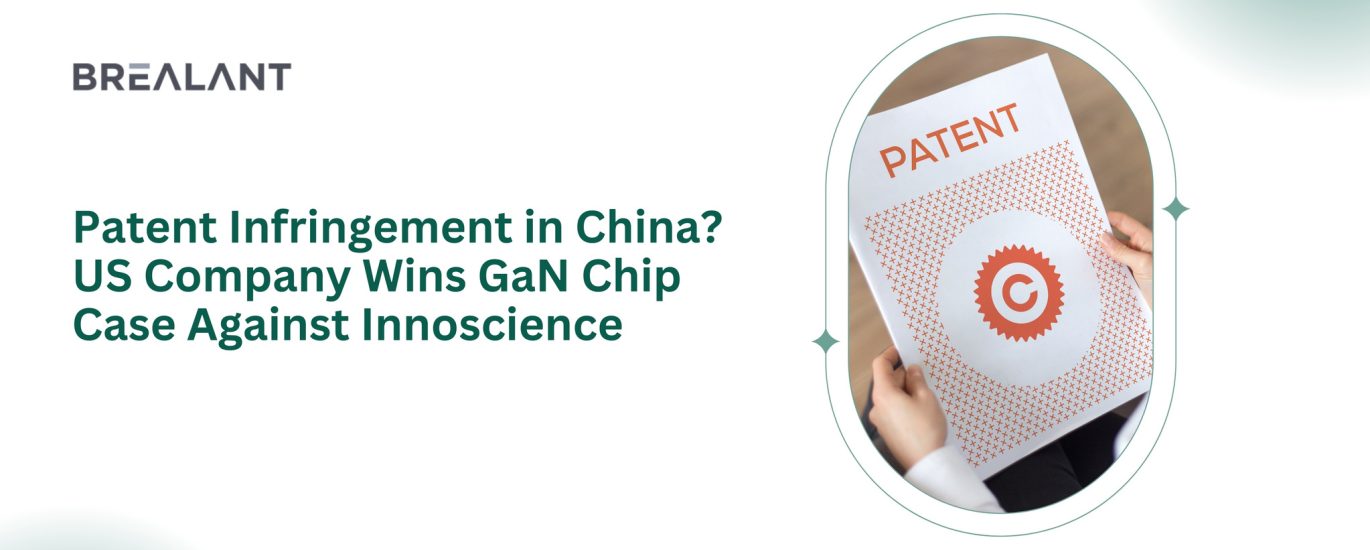



Intellectual property protection is important in safeguarding innovation and fostering advancements in the fiercely competitive global technology landscape. Patent infringement cases have become increasingly common, particularly in rapidly developing markets like China, where the proliferation of new technologies and products can lead to disputes over ownership and rights.
A recent case involving a US company and a Chinese technology firm (Innoscience) highlights the importance of protecting intellectual property in China. The case centres on patent infringement allegations related to gallium nitride (GaN) chips, a semiconductor material with wide applications in power electronics, including chargers, inverters, and electric vehicles. Let’s read more about the case.
The gallium nitride (GaN) has revolutionised the semiconductor industry. GaN is transforming sectors including electric cars, telecommunications, and renewable energy because of its exceptional performance and efficiency compared to conventional silicon-based processors. In one instance, a well-known American semiconductor manufacturer claimed that Innoscience, a top Chinese business specialising in GaN chips, had violated its patents. According to the U.S. corporation, Innoscience violated important patents about the design and manufacturing processes of GaN chips by copying its exclusive technologies.
Following a protracted legal struggle, the Chinese courts decided in favour of the American corporation, directing Innoscience to pay penalties and stop producing and selling the infringing items.
1. A Significant Development for China’s IP Enforcement
China has frequently come under fire for its lax IP enforcement, which has given the impression that it is a difficult place for international businesses to safeguard their inventions. This decision represents a step forward in China’s will to enforce patent rules and combat intellectual property theft.
2. Confirmation of the Strategic Significance of GaN
The conflict highlights GaN technology’s importance in the struggle for semiconductors. In addition to preserving its market dominance, the U.S. company’s victory in this lawsuit confirmed the importance of its advances in a crucial area.
3. Increasing the Trust of Investors
International investors and companies doing business in China could feel more confident that a foreign company to receive a favourable verdict. It proves that even in cases involving domestic businesses, the judicial system can provide just results.
1. Diversity in Law and Culture
China has a very different legal framework and approach to intellectual property than the West. Navigating these differences, such as comprehending procedural requirements and overcoming possible biases in favour of native enterprises, can be challenging for foreign companies.
2. The burden of proof
Patent holders must present strong evidence, to prove infringement. This can be especially difficult, in the semiconductor sector, where the technology is extremely sophisticated and private knowledge is strictly protected.
3. Innovation Speed
In a rapidly changing sector, like semiconductors, technical developments can surpass court cases. The contested technology could already be out of date by the time a decision is rendered, lessening the decision’s usefulness.
1. Invest in robust patents.
A strong patent portfolio is the cornerstone of every IP strategy. Businesses need to make sure their patents are thorough, properly written, and enforced in important areas, such as China.
2. Make Use of Local Knowledge
A comprehensive understanding of the complexities of China’s legal system is crucial for effectively navigating it. By partnering with local legal firms and intellectual property experts, foreign businesses can strengthen their arguments and avoid common pitfalls.
3. Keep an Eye on the Market
Vigilance is crucial for spotting possible violations. Businesses should invest in market information and monitoring technologies, to identify illegal usage of their technology early on.
4. Establish cooperative connections
Enforcement is important, but cooperation may also be a good tactic. Joint ventures and licensing agreements allow businesses to exchange technology, fostering goodwill and minimising conflicts legally.
Even if the decision is positive, more has to be done to improve China’s IP protection. Policymakers need to concentrate on:
∙enhancing the justice and openness of court procedures.
∙simplifying procedures to cut down on IP enforcement’s time and expense.
∙encourage IP education to cultivate an innovative and intellectual property-respecting culture.
Businesses must take a proactive, diversified strategy to survive China’s intellectual property ecosystem. Companies should protect their ideas by combining strong legal protections with strategic alliances and market awareness.
The U.S. company’s victory over Innoscience in the GaN chip patent dispute, a significant milestone for IP enforcement in China has been reached. It emphasises how important patents are for safeguarding innovation and influencing the direction of sectors like semiconductors. Strong intellectual property frameworks will be important for driving innovation, attracting investment, and fostering economic growth as the semiconductor sector evolves. This case demonstrates the ability of intellectual property to create a more equitable and vibrant technological future. Your brainchild should be protected from unwanted infringement and safeguarded under the guidance of Brealant’s IP professionals.